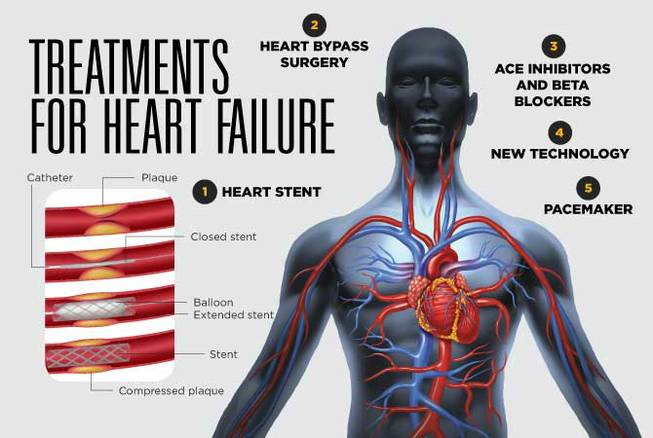
Sunday, Jan. 10, 2016 | 2 a.m.
Congestive heart failure is one of the most prevalent chronic heart diseases in America. The Centers for Disease Control and Prevention estimates 5.1 million people in the United States suffer from heart failure, and nearly half die within five years of being diagnosed. As with many heart diseases, there’s no cure, although medical advances have made congestive heart failure easier to predict, detect and manage.
“Damage to the heart can be prevented and sometimes even reversed, but for most patients it cannot be undone. Prevention and management are key,” said Dr. Ali Rahimi, MD, FACP, AGSF, Medical Director of the MountainView Heart Failure Clinic.
What is congestive heart failure?
Congestive heart failure is a chronic condition that occurs when the heart is unable to pump enough blood to supply the body. This is a result of damage to the heart muscle, often from coronary artery disease, heart attack, high blood pressure, obesity or aging.
“The circulatory system has a highly refined process,” Rahimi said. Every person has about 5 liters of blood in his or her body. The blood carries oxygen, nutrients, glucose, electrolytes and more, and distributes them throughout the body, which allows your organs to do their jobs. This process happens about 75 times a minute.
“If something prevents this process from happening as it should, such as congestive heart failure, the vital organs are starved from the nutrients they need,” Rahimi said.
Symptoms of heart failure
Congestive heart failure causes debilitating, even disabling, effects on the body, such as swelling of the feet and legs, shortness of breath and an inability to walk even short distances. Because of this, a dedicated team of multidisciplinary medical professionals is necessary when treating and managing heart failure.
Treatment and technologies
• Heart stent: A heart stent is a tiny mesh tube that is surgically inserted into an artery to keep it open after it has been narrowed by plaque buildup. This is a permanent measure that allows the blood to move more efficiently through the heart.
• Pacemaker: A pacemaker is a small device that’s inserted into the chest or abdomen. It sends soft electrical pulses to the heart, which manipulate the heart muscles into contracting and regulate the heart rate.
• Heart bypass surgery: This is an open-heart procedure that creates a new pathway within the heart for blood to move through once an artery has become blocked. New pathways are created by taking a blood vessel or vein from one part of the body (usually the chest, arms or legs) and connecting it to arteries in the heart, allowing blood flow to bypass the blockage.
• ACE inhibitors and beta blockers: These are two classes of prescription drugs used to treat congestive heart failure and high blood pressure. ACE inhibitors work by dilating blood vessels to allow more blood to pass through. Beta blockers work by slowing the heart rate, which in turn decreases the amount of oxygen the heart needs. Some patients may take only one or the other, or the medications can be prescribed together.
New technology
Tried-and-true methods can work effectively as part of a larger treatment plan, in tandem with lifestyle changes and regular medical monitoring. However, a new device recently approved by the FDA can further increase odds for success.
“The CardioMEMS HF System is a small device, implanted in the pulmonary artery, that allows doctors treating patients with heart failure to stay ahead of the game. We’re really excited to be able to offer this technology because it’s not widely available yet,” Rahimi said.
Using a tiny sensor, the device monitors pressure in the pulmonary artery, which indicates how well the blood is pumping, then sends electronic signals to the patient’s cardiologist daily. From the data, the doctor can gauge the patient’s ongoing progress, make treatment changes if necessary and intervene quickly in the event of a problem. The device is roughly the size of a paperclip and does not have wires or a battery.
While there are many types of heart implants, such as pacemakers and insertable cardiac monitors, this is the first that automatically sends daily updates straight to the doctor’s office, providing real-time, 24-hour monitoring. “Say for instance, I see some unusual feedback come up from the monitor. I can call my patient right then to ask them what’s going on,” Rahimi said. “It completely changes the collaborative process between doctor and patient when managing chronic conditions.”
The importance of prevention
While modern medicine continues to evolve and improve, it cannot replace a lifetime of good habits, nor can it reverse a lifetime of bad ones.
“Here’s the thing: Medicine means nothing without prevention,” Rahimi said. “Patients must be proactive and take preventative measures to protect their health or to manage their existing conditions.”
Indulging in an unhealthy diet, not exercising regularly, smoking, drinking excessively and high stress all can contribute to heart failure.
“Obesity is a very high risk factor, and smokers are in the same category,” Rahimi said. “Patients who are obese and smoke are ticking time bombs.”
Stress also can play a role in heart health and usually is most problematic when combined with one or more other risk factors.

Join the Discussion:
Check this out for a full explanation of our conversion to the LiveFyre commenting system and instructions on how to sign up for an account.
Full comments policy